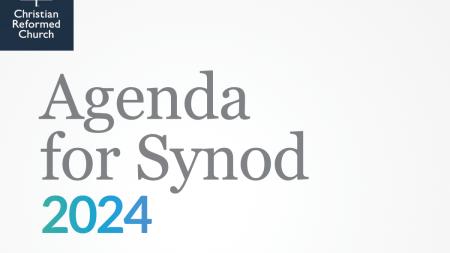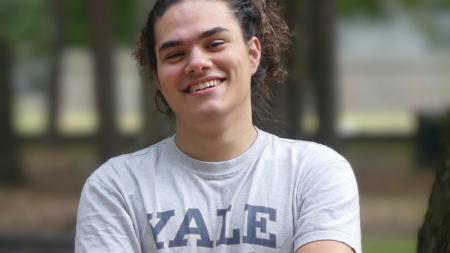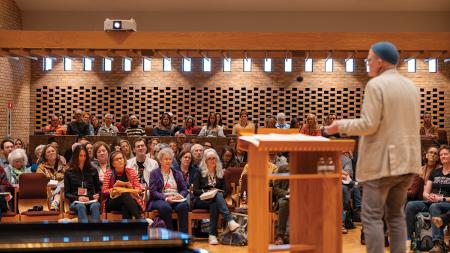Kaleidoscope Project Shines Light on Different Faiths

The interior of Saint Demetrios Greek Orthodox Church operated by the Hellenic Society of Calgary.
Moneer Alromimah
Last year, every day was a big surprise as Rev. Paul Verhoef helped lead a student group on a journey of interfaith discovery in Calgary, Alta.
The Christian Reformed Church chaplain at the University of Calgary led the group last year and again this year as part of the Kaleidoscope Project. Organized by the Faith and Spirituality Centre on campus, the week-long project aimed to encourage a more inclusive campus community by offering students diverse religious experiences and encouraging religious literacy.
Through the Kaleidoscope Project last year, Verhoef and more than 20 others visited several places of worship, including an Ismaili Jamatkhana, a Hindu Mandir, a Sikh Gurdwara, two Jewish Temples, and two Buddhist Temples.
“Honestly, last year’s event was full of surprises. Everything was new — and being inside these sacred spaces, hosted by the wonderfully hospitable people of these religious communities, was surprising every day,” said Verhoef.
Each day brought new questions about statues, about colors, about the architecture of the places they visited, and about the religious practices and cultural shape of each community.
But during this year’s second annual Kaleidoscope Project, he said, there were fewer surprises. He felt more familiar and was able to ask more probing questions.
Visits this year were similar to those in 2016 but also included being invited to observe a devotional time with people of the Baha’i faith and a trip to a Greek Orthodox church.
“This year, my questions were more personal — I wondered what a speaker loved about their practice, how their regular prayers or practices felt,” said Verhoef
As one of six leaders of the group, which consisted mainly of students from the University of Calgary, Verhoef asked people they met if they struggled with their religious practices feeling “ritualistic” or if they had moments when their regular practices felt more alive and more vibrant because of the deepening that regularity can provide.
“I also asked, ‘What were some favorite verses in the Quran (or other sacred text)? What do they pray about when on their own?’”
The students who attended this year’s program were from a diversity of backgrounds, identifying as either Christian, Muslim, Jewish, agnostic, spiritual, non-religious, or atheist. Majoring in everything from arts to engineering and science to developmental studies, the students were for the most part in their early twenties.
Students who took part in the program used these words to describe their experience: “the beginning,” “humbling,” “enriching,” “challenging,” and “transformative.”
Together with staff members of the Faith and Spirituality Centre at the University of Calgary, Verhoef helped to launch the project in 2015-2016. This year Verhoef was joined by four university staff members and another CRC chaplain, Pearl Nieuwenhuis.
“I have an image of myself (along with 26 others) being 'dunked' each day into a new religious community,” Nieuwenhuis said of this year’s experience.
“The dunking was, on the one hand, just an introduction — a tiny peek into the lived faith of one person and the sacred space shared with others in their religious community.
“The dunking was, on the other hand, intense — rich in surprises — the hospitality of each community was so beautiful; the openness and vulnerability of the students was humbling,” she said.
The main part of the program, said Verhoef, is an eight-day immersion experience — Saturday evening through the following Saturday afternoon — in which participants are introduced to various world religions (one per day) and make sacred-site visits to the religious community focused on that day.
They also look at a case study that sharpens some of the questions faced by these communities as they live out their faith in the world.
“There is reflection and debriefing around these daily, intense experiences, and, of course, meals together hosted by the religious community or a connected cultural community,” said Verhoef.
Every evening, the students and leaders gather as a large group for a “gratitude circle,” in which participants share something that they are thankful for about the day.
“Sometimes I notice that in the Christian community there is a fear that interfaith programs like this one give the impression that all faiths are generally the same,” Verhoef said.
“My experiences with students would suggest something quite different. While students see similarities, they also notice deep differences. And if the debriefing is done well, they are encouraged to wrestle with who they are and who they want to be in a world full of possibilities.”
For its work, the Kaleidoscope Project recently received the “Outstanding Spiritual Initiatives Award” at the 2017 NASPA Conference; NASPA is a leading association for student affairs professionals working in higher education.


